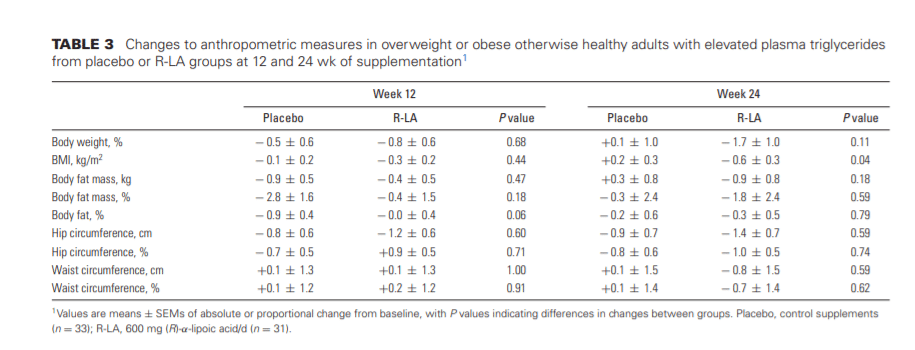
Alpha-lipoic acid is a naturally occurring compound in the human body. The primary function of this non-vitamin coenzyme is to convert glucose into energy and it also has strong antioxidant properties that aid in neutralizing harmful compounds that cause genetic damage to cells.
ALA is both water and fat-soluble which means it can either deliver energy immediately or store it for later use. It’s available for use as a dietary supplement, topical solution, or intravenous medication.
ALA supplementation is becoming increasingly popular as recent research has shown that it can help with diabetes, memory loss, inflammation, and many other conditions. In this article, we’ll discuss everything you need to know about ALA including its uses, proper dosage, side effects, and where to find the best ALA supplement.
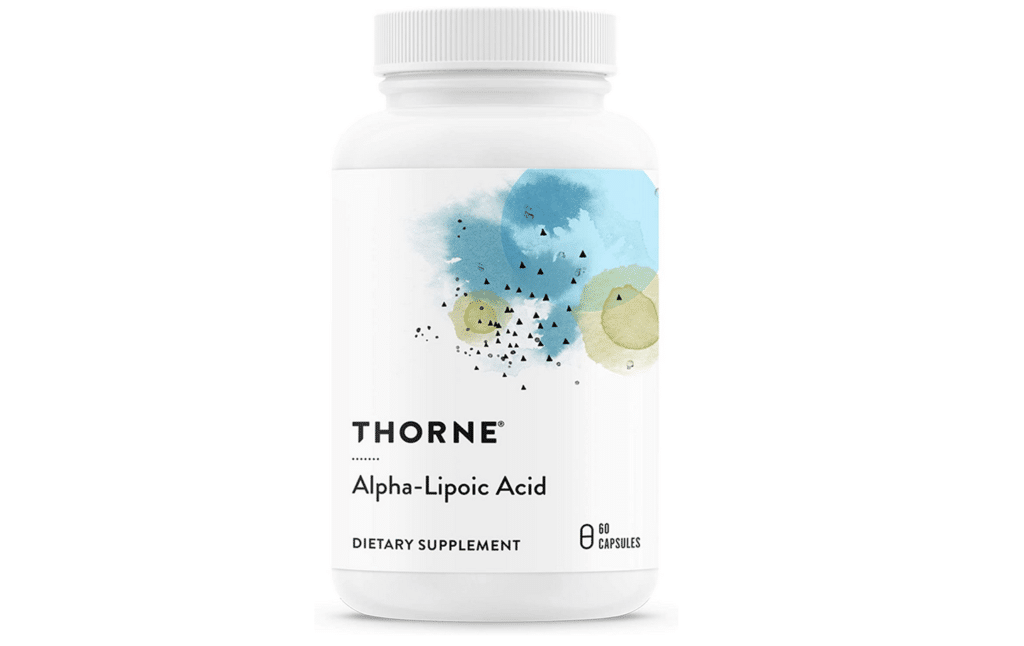
Looking for the best ALA supplement?
Thorne enjoys a stellar reputation among health professionals and professional sports leagues such as the NFL, UFC, NBA, and MLB.
Alpha Lipoic Acid Studies
Researchers have conducted numerous studies to determine how alpha-lipoic acid can be used as a conventional method of treatment for certain conditions. Studies have shown that ALA can help people suffering from diabetes, neuropathy, and inflammation. It has also been discovered that it can aid in weight loss and skin health.
Alpha Lipoic Acid For Neuropathy
Neuropathy is the numbing, tingling, or weakening of muscles of one or more body parts caused by nerve damage. It’s often a result of the oxidative stress placed on the nerves by chronic diseases like diabetes, kidney failure, thyroid disease, and HIV. While conventional treatments are available, some people prefer to use supplements to treat neuropathy as they often result in fewer side effects.
Several studies have concluded that ALA might help treat neuropathy caused primarily by diabetes or cancer treatment. Diabetic neuropathy can affect up to half of all people with diabetes and may interfere with daily activities.
Taking ALA has been shown to help relieve pain caused by diabetic neuropathy and some studies have found that taking ALA either orally or intravenously can relieve pain within three weeks of daily use. A recent study found that ALA may improve nerve function and alleviate unpleasant symptoms in the legs and arms, including tingling, prickling, numbness, burning, and itching. ALA increased nitric oxide-mediated, endothelium-dependent vasodilation, which resulted in improvements in microcirculation in diabetic polyneuropathy patients.
Another study published in 2017 revealed substantial evidence that alpha-lipoic acid can help protect against oxidative damage in diabetic neuropathy patients by improving nerve conduction and relieving neuropathic pain. In addition, a 2012 review of studies from the Netherlands also demonstrated that intravenous dosing of 600 mg alpha-lipoic acid provided “significant and clinically relevant reduction in neuropathic pain.
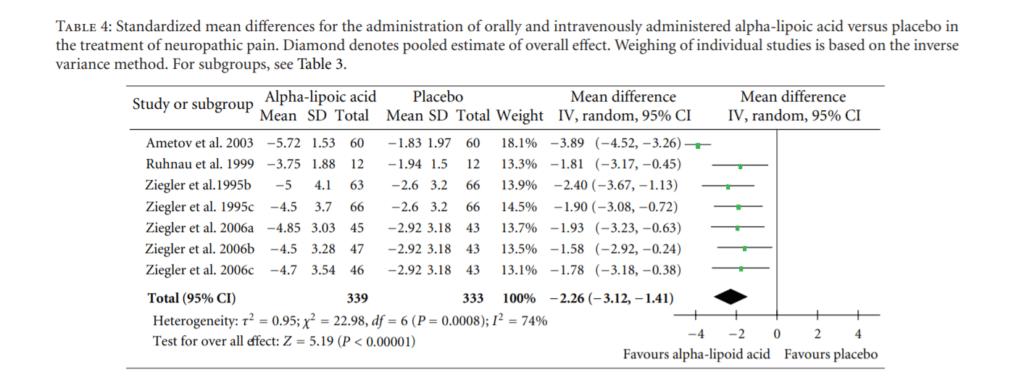
Alpha Lipoic Acid For Skin
ALA can raise the levels of other antioxidants that enhance your skin’s health and appearance. According to a 2010 study, ALA, when combined with other molecules like glutathione, can reduce the signs of aging because your skin suffers less free radical molecular damage.
Furthermore, ALA has been shown to lighten dark spots in sun-damaged skin. In a 2019 study, researchers discovered that using nanocapsule technology to administer ALA topically can reduce pigmentation caused by photoaging in vitro in guinea pigs. Researchers developed the novel nanocapsule of α-lipoic acid named α-lipoactive (nLA) to improve skin permeability. They observed an epidermal thickening caused by the a-lipoic acid molecule after applying nLA to murine skin. However, more data is required to back up this claim.
Another study found that ALA can speed up wound healing after examining the effect of applying ALA topically to wounds created by surgical incision. According to the researchers, the animals treated with alpha-lipoic acid had a faster healing rate on the seventh day after surgery. However, since these were not human trials, future results may not be as potent as expected when applied to humans.
Alpha Lipoic Acid For Inflammation
The anti-inflammatory effects of ALA stem from its potent antioxidant properties. Most of the chronic inflammation ALA can alleviate is caused by oxidative stress.
ALA is able to reduce inflammation in asthmatic airways and according to a 2004 study, ALA can be a practical addition to bronchial asthma therapy. Researchers tested ALA’s therapeutic effect in a mouse model of asthma. It was discovered that the mice treated with alpha-lipoic acid had significantly reduced hyperresponsiveness or increased sensitivity of the airways to various stimuli. ALA was also found to improve pathologic lesion scores in the lungs substantially.
In another mice study, researchers found that ALA can be a new adjunctive therapy for rheumatoid arthritis. Findings revealed that ALA was linked to a dose-dependent reduction in collagen-induced arthritis (CIA) in mice and protection from bone erosion and destructive changes. It also aided in suppressing inflammatory cytokine activation which promotes joint destruction.
Alpha Lipoic Acid For Weight Loss
ALA supplements have gained popularity among supplement manufacturers and diet gurus and there’s growing evidence that taking ALA may result in small, but significant weight reductions.
In a 2017 systematic review and analysis from Yale University, researchers discovered that taking ALA in doses ranging from 300 to 1,800 mg daily resulted in an average weight loss of 1.27 kg compared to the placebo group, which was statistically significant and led to a change of −0.43 in the body mass index. The changes occurred in the short-term than in the long term.
There was no correlation between the amount of weight loss and the dose of the alpha-lipoic supplement. Furthermore, the length of the treatment appeared to influence a person’s BMI, but not their actual weight.
In a double-blind, placebo-controlled randomized study overweight, but otherwise healthy, adults took 600 mg/day of R-ALA (the natural form of the compound) for 24 weeks. It led to significant BMI, body fat, weight loss, reduced inflammation, and increased antioxidant enzyme synthesis. Women experienced a more substantial impact, with 42 percent achieving substantial weight loss equivalent to losing 5% or more body mass.
Another study found that taking 1,800 mg of ALA a day led to a more significant weight reduction than taking 1,200 mg/day in obese individuals. The randomized, double-blind, placebo-controlled study also suggested that the most common adverse events in the ALA group were urticaria and itching sensation, but these were generally mild and transient. As a result, the researchers concluded that ALA could be used as adjunctive therapy for obesity.
So, does ALA really help with weight loss? According to one study, ALA’s antioxidant capabilities may benefit body composition. However, much of the proposed mechanism for weight loss revolves around ALA’s suppression of AMP-activated protein kinase (AMPK, or 5’-adenosine monophosphate-activated protein kinase), a key regulator of energy production, appetite, and food intake. This effect on AMPK may increase satiety, resulting in reduced food intake, increased energy expenditure, and promoting fat oxidation.
While these studies show that ALA can aid in weight loss, the effects are minimal. In many studies, taking ALA supplements along with following a calorie-restricted diet and performing exercise increased led to the greatest results. Thus, ALA should be considered a beneficial component to comprehensive weight-loss treatment and not the main tool used to achieve weight loss.
Alpha Lipoic Acid For Diabetes
One of the earliest possible applications for alpha-lipoic acid was determined to be in the management of diabetes mellitus. Several studies have found that ALA may aid in the treatment of diabetes by increasing the breakdown of sugar in the body.
Medical studies have shown that taking ALA orally has improved the health of Type 2 diabetes patients. Some scientists believe that oral administration of ALA has many limitations in terms of efficacy compared to intravenous infusion. But, due to the inherent risks and uncertainties of intravenous administration of ALA in clinical practice, it is not likely to be available soon.
Alpha Lipoic Acid Side Effects
Like any other drug available to the general public, ALA has several non-life-threatening side effects and each person’s reaction to ALA is unique. Before you begin taking ALA, you should be aware of the potential side effects and how to deal with them.
Alpha Lipoic Acid Headache
Headache is one of the most prevalent side effects resulting from ALA consumption. According to one study, ALA can trigger headaches in patients. These headaches aren’t life-threatening, but they can cause minor discomfort and a loss of concentration.
Alpha Lipoic Acid Skin Rash
Skin rash is another notable side effect associated with the use of ALA. According to one study, skin rash was one of the most common allergic reactions to oral consumption of alpha-lipoic acid.
Skin rash is capable of causing discomfort and, in some cases, scarring the skin if not properly treated. Furthermore, skin rash can cause an increase in body temperature because the area where it occurs can become hot.
Alpha Lipoic Acid Stomach Discomfort
Some people may experience stomach pain after consuming ALA. One study found that oral ingestion of ALA was linked to stomach discomfort.
Alpha Lipoic Acid Diarrhea
Another known side effect of taking ALA is diarrhea. In a small sample size study done to determine the tolerability of ALA in an elderly population, it was found that some subjects had experienced gastrointestinal side effects, including diarrhea, which is characterized by watery stools, nausea, and vomiting.
Diarrhea is a severe medical condition that could be life-threatening if left untreated. You should seek medical attention once you notice these symptoms of diarrhea.
Alpha Lipoic Acid Urine Odor
Abnormal urine odor is the most prominent side effect of taking ALA supplements. In the same study mentioned above, three different doses of ALA were evaluated in the elderly population. One of the most common unfavorable effects they reported was urine odor.
Although an unpleasant odor in your urine, similar to sulfur or skunk, may be a little disturbing, this side effect is harmless. However, if a burning sensation accompanies the pungent odor, we recommend seeing a doctor.
Other Considerations
While taking ALA is generally considered safe, there are certain individuals who should be monitored by a healthcare professional while using this supplement. Because ALA affects serum glucose levels, people with diabetes using ALA should be closely monitored to avoid hypoglycemia or low blood sugar.
Due to a lack of concrete medical data on the use of ALA by children, nursing mothers, and pregnant women, these groups should avoid taking ALA supplements. They can, however, consume foods that contain ALA in its natural form.
How to Use Alpha Lipoic Acid
Because the body’s production of ALA is insufficient to meet the daily recommended amount, some people turn to supplementation for optimal health. However, before purchasing ALA you must understand how to use it for each use case.
It’s worth noting that an ALA supplement should be taken before eating.
Alpha Lipoic Acid Dosage
Diabetes
For controlling diabetes, it is recommended that you take 600 to 1,800 mg of ALA daily. Since people with diabetes need to maintain low blood sugar levels, consuming a high dose of ALA will accelerate the process of glucose breakdown in the body.
Pain
The daily recommended dosage of ALA for pain relief is between 300 and 1,800 mg. It is best to follow the doctor’s ALA recommendations in terms of mg per day and number of days to avoid becoming addicted to the supplement as a painkiller.
You may experience mild headaches, abdominal pain, and diarrhea after discontinuing the use of ALA.
Antioxidant
Taking ALA as an antioxidant requires limiting your daily dosage to 20–50 mg. This recommended dosage will help you expel radicals from your body system without negatively impacting your health.
When To Take Alpha Lipoic Acid
There are numerous viewpoints on when to take ALA, but the consensus is that it should be taken on an empty stomach. The stomach’s acidic pH is typically very high in the morning, and you can take ALA at this time to maximize absorption.
Furthermore, according to studies, the human body absorbs approximately 30-40% of ALA. This figure is considerably low, given that the quantity produced in the body is not sufficient for healthy living.
What To Look For When Buying Alpha Lipoic Acid
The supplement market is flooded with a range of ALA supplements that claim to provide users with various health benefits. But it can be hard to know which are worth investing in.
So, we recommend that you conduct extensive research on the product and its manufacturer prior to making a purchase. You should also ask yourself the following questions:
- Does it have any other ingredients?
- Where was it manufactured?
- Was it subjected to quality control?
- Does the manufacturer have a certification?
- What is its price range?
Here are some other important factors to consider when buying ALA supplements.
Purity
Purity is one of the most critical factors to look for in ALA supplements. We always discuss purity in our reviews because the supplement market is already full of products claiming to provide specific health benefits they don’t actually have. It can also be dangerous if the supplement contains a particular ingredient.
This is why you should look for a brand that has been third-party tested for purity and potency to ensure that their ALA content is genuine and provides tangible benefits to users.
Brand Certification
It’s also important to know if the brand is certified to ensure that the supplement went through a tightly controlled quality control and sanitization process to ensure that none of the ingredients were compromised before they were bottled up.
Added Ingredients
Another factor to consider is the supplement’s additional ingredients. Some people may prefer vegan-friendly brands that contain other nutritional ingredients, such as grape seed oils and turmeric powder, that may contribute to the product’s potency.
Price And Dosage
Of course, you should not forget about the price range. ALA supplements come with enough capsules for a very low price, while others are more expensive due to the product’s features. Some contain 100-600mg of ALA, while others contain 600 or more mg. If you get a healthy amount of ALA from food, taking high-dose supplements may not be necessary, a waste of money, and potentially dangerous in the long run.
Form
Supplements come in various forms including capsules, liquid, or powder. Some people prefer liquid or powder form if they have difficulty swallowing capsules or tablets, so this aspect of the product should also be considered when purchasing an ALA supplement.
How We Review Supplements, Equipment, And Wellness Products
While scientific research can provide helpful information about how a supplement may affect humans, it can only tell you so much. Some supplements have only been studied a few times, while others have been studied in small populations.
Add to this the fact that other studies are done primarily in sick populations, yet the supplements are also advertised for healthy people.
This is where user reviews come into play.
The stories shared by real people who used a supplement for months should give you a clearer picture of it. You can try searching the internet for these individuals, who are frequently from niche and expert communities such as athletes or nootropics users.
It’s also important to read reviews on Amazon or other websites selling supplements, but proceed with caution because fake reviews have become widespread.
However, our evaluation does not stop there. We always make sure that the brands we recommend are good and the right brands. This is why we look for credibility indicators such as certifications, third-party analysis, a credible Amazon seller page, and positive ratings.
We explain what’s in the product, provide photos of the product and its nutritional label, and test the products ourselves to compare and find each brand’s strengths and weaknesses to help you decide which brands to buy.
What Are The Most Trustworthy Alpha Lipoic Acid Brands?
Thorne
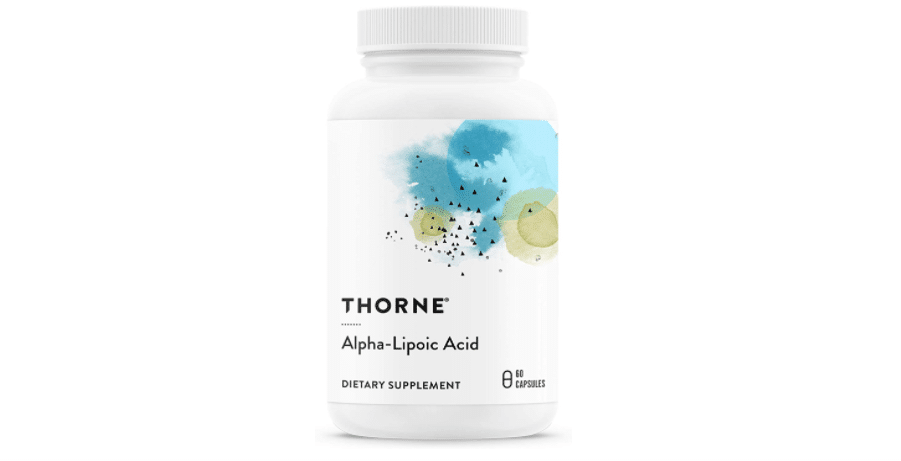
Thorne has a reputation as being one of the best supplement brands and is commonly recommended by health professionals and professional sports leagues. Its also been given an “A” rating by Australia’s Therapeutic Goods Agency, a regulatory institution with some of the highest standards.
Toniq
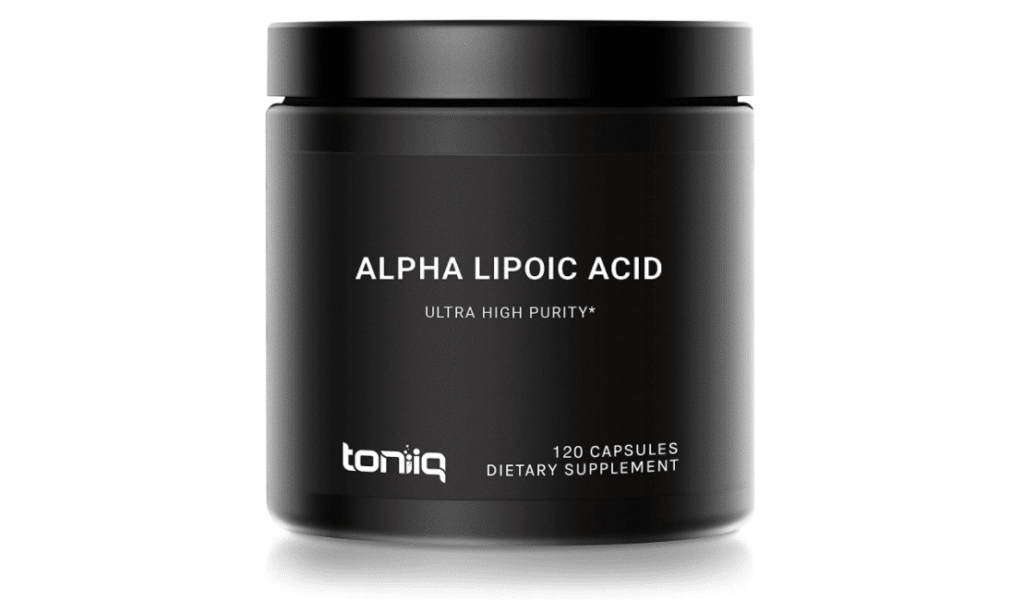
Toniq has a strict laboratory testing protocol, which it publicly displays to ensure the safety of its purchasers. Each product is tested for quality and purity and manufactured in a GMP-certified and NSF-approved manufacturing facility in the United States.
Life Extension
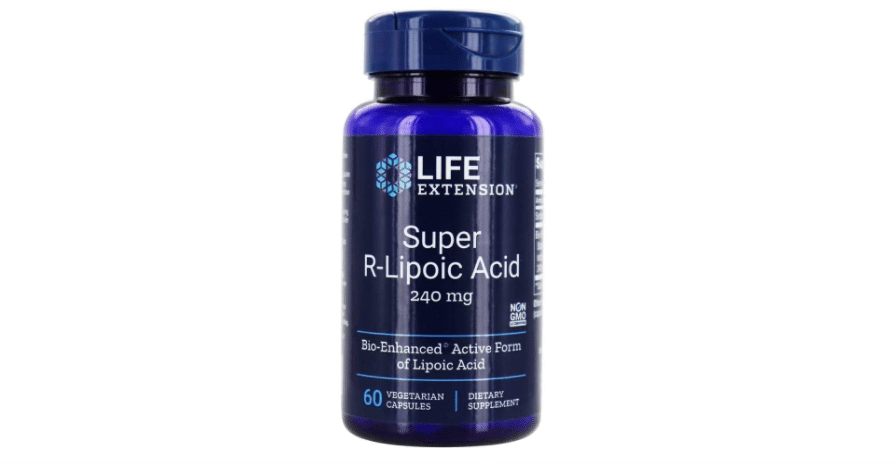
Life Extension is all about research and innovation and has been in the supplement game for over 40 years. All of its products’ formulations are based on the latest nutritional science and are manufactured in the US.
Life Extension is also transparent about its practices, follows strict procedures, and enrolls in independent lab testings.
Nutricost
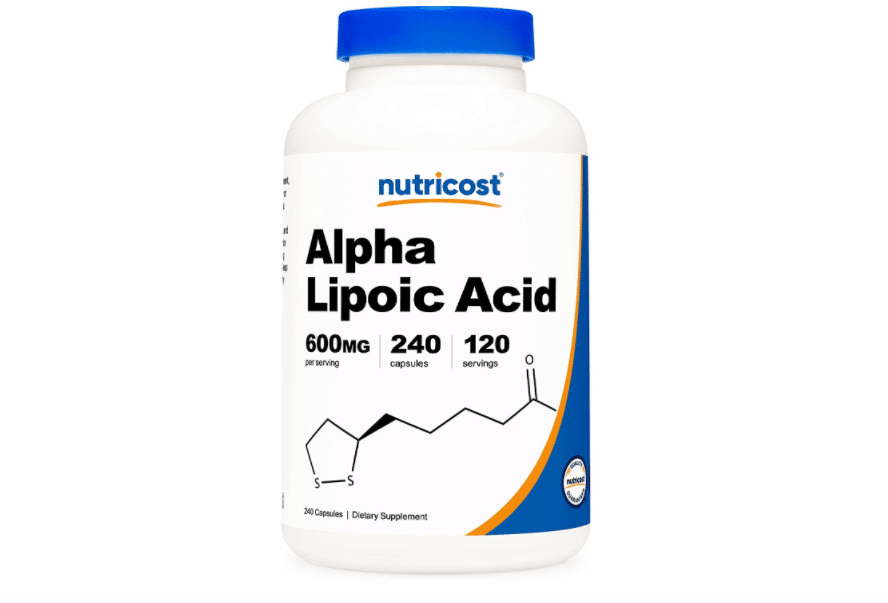
All of Nutricost’s supplements are manufactured in a GMP-compliant facility and are made with some of the highest quality ingredients available. Nutricost is one of the most affordable supplement brands and is dedicated to the use of simple formulations for its products.
Bulk Supplements
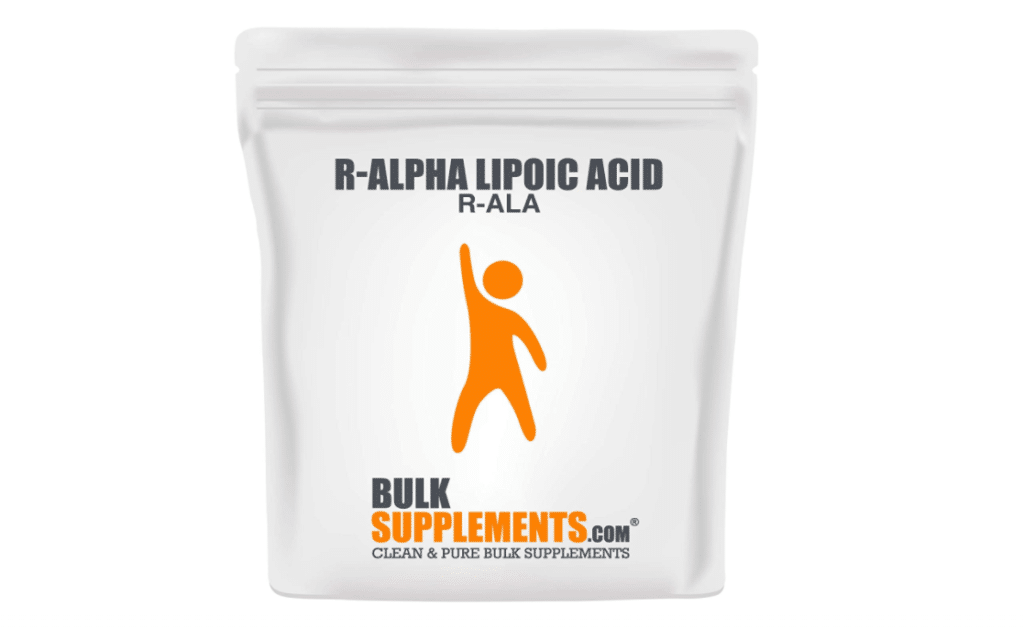
As its name implies, Bulk Supplements offers a variety of vitamins, minerals, and supplements in bulk, and sells its products in quantities ranging from just a few grams up to several metric tons. Bulk Supplements sells supplements in pure powder form and offers one of the most cost-effective approaches to supplementation to date.
Its manufacturing and distribution facility is NSF Certified & FDA-registered cGMP and each of its products is tested in its in-house laboratory before distribution, ensuring that all products are safe for consumption.
Looking To Buy Alpha Lipoic Acid? Read Our Review Of The Best Alpha Lipoic Acid Supplements
Alpha Lipoic Acid FAQs
How long does it take for alpha-lipoic acid to work for neuropathy?
There’s no definite time for alpha-lipoic acid to work for neuropathy, as it varies from person to person. However, most consumers have stated that they felt better after one to ten days of taking an ALA supplement.
Anecdotally, ALA supplements have been popular for their immediate effects, but studies show that diabetic patients with neuropathy who take ALA for three weeks have less pain and numbness.
Where in the body is alpha-lipoic acid found?
ALA is found in all human cells. It is produced inside the mitochondrion where it aids enzymes in converting glucose to energy.
When is the best time to take alpha lipoic acid?
It is recommended for people with diabetes to take ALA on an empty stomach, or half an hour to two hours before eating, preferably in the morning to early afternoon. They may also take it three hours after a meal.
Non-diabetics can take ALA anytime with food or on an empty stomach, but preferably on an empty stomach because certain foods can reduce ALA’s bioavailability.
How much alpha-lipoic acid should I take for neuropathy?
Since ALA is still an unproven treatment, there is no standard dosage for each condition. However, several studies have used 600-1,200 mg daily for the treatment of neuropathy.
According to one review, there is compelling evidence for the use of 600 mg ALA daily for three weeks on diabetic neuropathy symptoms.
What is the best form of alpha-lipoic acid?
Alpha-lipoic acid exists in three forms: R-lipoic acid, S-lipoic acid, and RS-lipoic acid. The R-lipoic acid is superior among the three forms.
R-lipoic acid is the natural form of ALA found in animals, plants, and humans. It is the only form that functions as a cofactor for mitochondrial enzymes involved in energy production. R-lipoic acid is more potent than regular ALA because the body recognizes it and knows how to use it, making it the best form of ALA.
On the other hand, S-lipoic acid and RS-lipoic acid are synthetic. According to research, the human body has difficulty absorbing the S version, which may inhibit the essential properties of natural R-lipoic acid.
How much alpha-lipoic acid should a diabetic take?
While most studies on ALA in diabetes have focused on its effects on neuropathy, several clinical trials have discovered that ALA can increase insulin sensitivity and help reduce blood sugar and lipids, thus improving oxidative stress and inflammation measures.
The typical ALA dose for diabetes treatment is 200 to 400 mg three times per day, for a total amount of 600 mg to 1,200 mg.
How does alpha-lipoic acid work?
As an antioxidant, ALA can help your body prevent various types of cell damage and restore vitamin levels, particularly vitamins C and E. It eliminates free radical molecules that harm healthy cells or prevent them from functioning properly.
Furthermore, your body uses ALA to break down various carbohydrates, freeing up energy for your organs and other systems to use.
How long does alpha lipoic acid stay in your system?
According to scientific evidence, alpha-lipoic acid has a short half-life in the human body. ALA typically stays in the body for 30 minutes to an hour.
In addition to its short duration in the body, ALA has a low bioavailability rate, typically caused by its reduced solubility, hepatic degradation, and inconsistency of the stomach’s acidic pH. Therefore, it’s best to take ALA on an empty stomach, where it can benefit from the stomach’s acidic pH for maximum absorption.
What is the difference between alpha lipoic acid and R-lipoic acid?
The significant difference between alpha-lipoic acid and R-lipoic acid is that ALA Is an organosulfur compound that majorly acts as an antioxidant. At the same time, RLA is an enantiomer of ALA that exists naturally and acts as a cofactor during energy production in both animal and plant cells.
Both ALA and RLA have vitamin-like structures, and they are necessary for the body’s optimal function.
What does alpha lipoic acid do for the skin?
Because of its antioxidant properties, ALA has been shown to aid in preventing skin aging, radiation damage, and smoking-related skin damage. It has also been discovered that it can help in wound healing.
What are the side effects of taking ALA?
People taking ALA may develop skin rash and experience nausea. Because ALA is an acid, it can also contribute to acid reflux.
In addition, ALA may also interfere with thyroid function, medication, and diagnostic tests, so it’s better to check with your doctor first. Although rare, ALA may cause insulin autoimmunity.
What are the benefits of alpha-lipoic acid?
Here are the most commonly studied benefits of using ALA:
Diabetes Management – Evidence suggests that taking 600 mg of ALA orally can improve blood sugar levels in people with diabetes.
Skin Health – Research has shown that ALA can help reduce fine lines, wrinkles, and skin roughness. It can also help lighten dark spots caused by sun damage and speed up wound healing.
Nerve Pain – As mentioned above, ALA can help with neuropathy or the tingling sensation, pain, or numbness experienced by people with diabetes, Lyme disease, thyroid disease, HIV, and kidney failure.
Weight Loss – Studies have shown that ALA can aid in losing weight, and taking a daily dose of 1800 mg can help in weight reduction.
Heart Disease – According to research from the lab, animal, and human studies, ALA’s antioxidant properties reduce oxidative stress, linked to damage that increases the risk of heart disease. It can also help with endothelial dysfunction, a condition in which blood vessels are unable to dilate properly, increasing the risk of a heart attack or stroke.
Studies You Can Read About Alpha Lipoic Acid
- Alpha-Lipoic Acid– (Statpearls Publishing, 2021)
- Effect of alpha-lipoic acid supplementation on oxidative stress markers and anti oxidative defense in patients with diabetic neuropathy (atherosclerosis,2017)
- Alpha Lipoic Acid for Symptomatic Peripheral Neuropathy in Patients with Diabetes: A Meta-Analysis of Randomized Controlled Trials (International Journal of Endocrinology, 2012)
- Modern approach to topical treatment of aging skin (National Library of Medicine, 2010)
- Novel nanocapsule of α-lipoic acid reveals pigmentation improvement: α-Lipoic acid stimulates the proliferation and differentiation of keratinocyte in murine skin by topical application (John Wiley & Sons Ltd., 2019)
- Evaluation of lipoic acid topical application on rats skin wound healing (Acta Cir. Bras, 2013)
- alpha-Lipoic acid inhibits airway inflammation and hyperresponsiveness in a mouse model of asthma (The Journal of Allergy and clinical Immunology,2004)
- Alpha-lipoic acid suppresses the development of collagen-induced arthritis and protects against bone destruction in mice (Rheumatol Int, 2006)
- Alpha-lipoic acid (ALA) as a supplementation for weight loss: results from a meta-analysis of randomized controlled trials (Obesity Reviews, 2017)
- A Randomized Controlled Trial of Long-Term (R)-α-Lipoic Acid Supplementation Promotes Weight Loss in Overweight or Obese Adults without Altering Baseline Elevated Plasma Triglyceride Concentrations (The Journal of Nutrition, 2020)
- Effects of Alpha-Lipoic Acid on Body Weight in Obese Subjects (The American Journal of Medicine, 2010)
- Untargeted metabolomic on urine samples after α-lipoic acid and/or eicosapentaenoic acid supplementation in healthy overweight/obese women (Lipids Health and Disease, 2018)
- Effect of the administration of alpha-lipoic acid on contrast sensitivity in patients with type 1 and type 2 diabetes (Mediators of Inflammation, 2014)
Editor’s note: we are regularly updating this review. If you see any problems, weird interpretations of the data, or just want to say hi, please reach out to hello@the-unwinder.com.
Photo by Anna Shvets from Pexels
